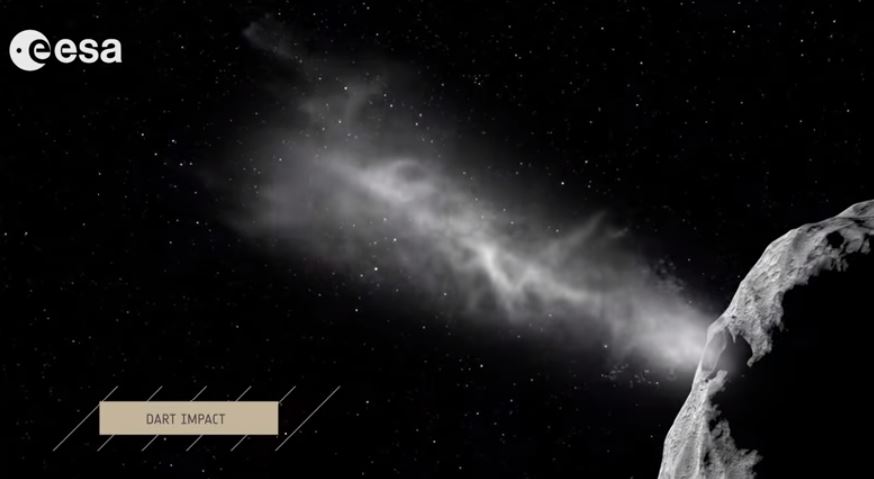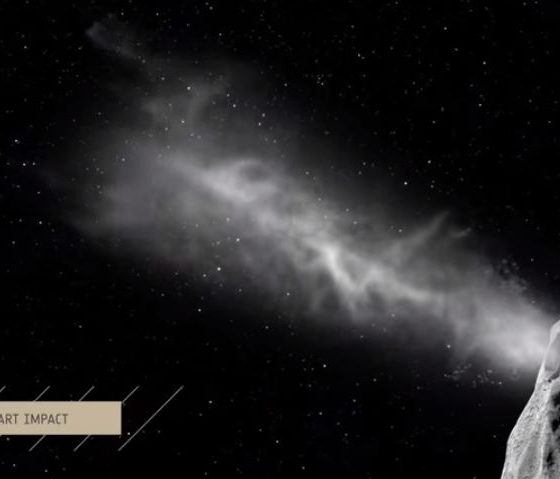

News
NASA is crashing a satellite into an asteroid to gather data about asteroid deflection
The threat of asteroids crashing into Earth isn’t a new concern. We’ve been warned about it by science fiction authors and Hollywood alike, and any kid that’s ever paid attention to dinosaurs in school knows there are bad outcomes when life and chunks of space rock meet up. The space agencies of Europe and the United States are not blind to the threat, thankfully, and they have a multi-part satellite mission in the works directed to gathering real data on how to redirect an asteroid with bad intentions for our planet, i.e., is on a collision course. Specifically, they’re planning on crashing one satellite into an asteroid and studying the effect with another satellite run by the European Space Agency (ESA).
NASA’s part of the mission is called the Double Asteroid Redirection Test (DART), and it will serve as the first demonstration of changing asteroid motion in space. The launch window begins in late December 2020, most likely on track for June 2021, for arrival at its targeted asteroid, Didymos, in early October 2022. Didymos is Greek for “twin”, the name being chosen because it’s a binary system with two bodies: Didymos the asteroid, about a half mile across, and Didymoon the moonlet, about 530 feet across, acting as a moonlet. The two currently have a Sun-centric orbit and will have a distant approach to Earth around the same time as DART’s launch window and then again in 2024.
After reaching the asteroid, DART will enter orbit around Didymoon, and crash into it at a speed of about 4 mi/s (nine times faster than a bullet) to change its speed by a fraction of one percent, an amount measurable by Earth-based telescopes for easy study. Unsurprisingly, the preferred description is “kinetic impact technique” rather than “crash” – maybe even “impact” or “strike”, if we’re avoiding terms that sound random or accidental. The mission is being led by the Johns Hopkins Applied Physics Laboratory (JHU/APL) and managed by the Planetary Missions Program Office at Marshall Space Flight Center in Alabama for NASA’s Planetary Defense Coordination Office.

NASA’s DART mission is one of two parts of an overall mission dubbed AIDA (Asteroid Impact & Deflection Assessment). Joining the agency’s Earth-protection venture is the ESA with its Hera spacecraft, named after the Greek goddess of marriage, a probe that will follow up DART’s mission with a detailed survey of the asteroid’s response to the impact. Collected data will help formulate planetary defense plans by providing detailed analysis from DART’s real-time asteroid deflection experiment. Its launch is scheduled for 2023.
Just this month, another part was added to Hera’s mission: CubeSats. This class of tiny satellites is about the size of a briefcase, and they recently made their deep space debut during NASA’s Mars InSight landing. During that mission, twin CubeSats collectively named MarCO followed along on the journey to Mars behind InSight, eventually relaying data during the landing event back to NASA’s Mission Control along with a photo of the red planet. ESA’s CubeSats, named APEX (Asteroid Prospection Explorer) and Juventas, will travel inside Hera, gather data on Didymos and its moonlet, and then both will land on their respective rocks and provide imaging from the surface.

Just to recap: Tiny satellites in a class that students and startups can and have developed and launched will travel into deep space and land on asteroids. This is big news for the democratization of space travel. As emphasized by Paolo Martino, Hera’s lead engineer in ESA’s article announcing the CubeSat mission, “The idea of building CubeSats for deep space is relatively new, but was recently validated by NASA’s InSight landing on Mars last November.”
Using kinetic energy – pure ram/crash force – isn’t the only option NASA is looking at for defending Earth from incoming asteroids. A “gravity tractor” concept would orbit a craft in a way that would change the trajectory due to gravitational tugging. Similar to how our moon has an impact on our tides or the Earth makes the Sun wobble ever so slightly, a satellite orbiting an asteroid would give pushes and pulls to set its course elsewhere.
Unfortunately, a gravity tractor likely wouldn’t be very effective for asteroids large enough to seriously threaten our planet. Also, the techniques for achieving it would require decades to develop and test in space. Laser ablation, or using spacecraft lasers to vaporize asteroid rock to change an asteroid’s course, is another technique NASA has considered, but it might be just as feasible or cost-effective to simply launch projectiles to achieve the same purpose.
Watch the below video for a visual overview of the DART and HERA missions:

Elon Musk
Elon Musk’s X will start using a Tesla-like software update strategy
The initiative seems designed to accelerate updates to the social media platform, while maintaining maximum transparency.

Elon Musk’s social media platform X will adopt a Tesla-esque approach to software updates for its algorithm.
The initiative seems designed to accelerate updates to the social media platform, while maintaining maximum transparency.
X’s updates to its updates
As per Musk in a post on X, the social media company will be making a new algorithm to determine what organic and advertising posts are recommended to users. These updates would then be repeated every four weeks.
“We will make the new 𝕏 algorithm, including all code used to determine what organic and advertising posts are recommended to users, open source in 7 days. This will be repeated every 4 weeks, with comprehensive developer notes, to help you understand what changed,” Musk wrote in his post.
The initiative somewhat mirrors Tesla’s over-the-air update model, where vehicle software is regularly refined and pushed to users with detailed release notes. This should allow users to better understand the details of X’s every update and foster a healthy feedback loop for the social media platform.
xAI and X
X, formerly Twitter, has been acquired by Elon Musk’s artificial intelligence startup, xAI last year. Since then, xAI has seen a rapid rise in valuation. Following the company’s the company’s upsized $20 billion Series E funding round, estimates now suggest that xAI is worth tens about $230 to $235 billion. That’s several times larger than Tesla when Elon Musk received his controversial 2018 CEO Performance Award.
As per xAI, the Series E funding round attracted a diverse group of investors, including Valor Equity Partners, Stepstone Group, Fidelity Management & Research Company, Qatar Investment Authority, MGX, and Baron Capital Group, among others. Strategic partners NVIDIA and Cisco Investments also continued support for building the world’s largest GPU clusters.
News
Tesla FSD Supervised wins MotorTrend’s Best Driver Assistance Award
The decision marks a notable reversal for the publication from prior years, with judges citing major real-world improvements that pushed Tesla’s latest FSD software ahead of every competing ADAS system.

Tesla’s Full Self-Driving (Supervised) system has been named the best driver-assistance technology on the market, earning top honors at the 2026 MotorTrend Best Tech Awards.
The decision marks a notable reversal for the publication from prior years, with judges citing major real-world improvements that pushed Tesla’s latest FSD software ahead of every competing ADAS system. And it wasn’t even close.
MotorTrend reverses course
MotorTrend awarded Tesla FSD (Supervised) its 2026 Best Tech Driver Assistance title after extensive testing of the latest v14 software. The publication acknowledged that it had previously criticized earlier versions of FSD for erratic behavior and near-miss incidents, ultimately favoring rivals such as GM’s Super Cruise in earlier evaluations.
According to MotorTrend, the newest iteration of FSD resolved many of those shortcomings. Testers said v14 showed far smoother behavior in complex urban scenarios, including unprotected left turns, traffic circles, emergency vehicles, and dense city streets. While the system still requires constant driver supervision, judges concluded that no other advanced driver-assistance system currently matches its breadth of capability.
Unlike rival systems that rely on combinations of cameras, radar, lidar, and mapped highways, Tesla’s FSD operates using a camera-only approach and is capable of driving on city streets, rural roads, and freeways. MotorTrend stated that pure utility, the ability to handle nearly all road types, ultimately separated FSD from competitors like Ford BlueCruise, GM Super Cruise, and BMW’s Highway Assistant.
High cost and high capability
MotorTrend also addressed FSD’s pricing, which remains significantly higher than rival systems. Tesla currently charges $8,000 for a one-time purchase or $99 per month for a subscription, compared with far lower upfront and subscription costs from other automakers. The publication noted that the premium is justified given FSD’s unmatched scope and continuous software evolution.
Safety remained a central focus of the evaluation. While testers reported collision-free operation over thousands of miles, they noted ongoing concerns around FSD’s configurable driving modes, including options that allow aggressive driving and speeds beyond posted limits. MotorTrend emphasized that, like all Level 2 systems, FSD still depends on a fully attentive human driver at all times.
Despite those caveats, the publication concluded that Tesla’s rapid software progress fundamentally reshaped the competitive landscape. For drivers seeking the most capable hands-on driver-assistance system available today, MotorTrend concluded Tesla FSD (Supervised) now stands alone at the top.
News
Elon Musk’s Grokipedia surges to 5.6M articles, almost 79% of English Wikipedia
The explosive growth marks a major milestone for the AI-powered online encyclopedia, which was launched by Elon Musk’s xAI just months ago.

Elon Musk’s Grokipedia has grown to an impressive 5,615,201 articles as of today, closing in on 79% of the English Wikipedia’s current total of 7,119,376 articles.
The explosive growth marks a major milestone for the AI-powered online encyclopedia, which was launched by Elon Musk’s xAI just months ago. Needless to say, it would only be a matter of time before Grokipedia exceeds English Wikipedia in sheer volume.
Grokipedia’s rapid growth
xAI’s vision for Grokipedia emphasizes neutrality, while Grok’s reasoning capabilities allow for fast drafting and fact-checking. When Elon Musk announced the initiative in late September 2025, he noted that Grokipedia would be an improvement to Wikipedia because it would be designed to avoid bias.
At the time, Musk noted that Grokipedia “is a necessary step towards the xAI goal of understanding the Universe.”
Grokipedia was launched in late October, and while xAI was careful to list it only as Version 0.1 at the time, the online encyclopedia immediately earned praise. Wikipedia co-founder Larry Sanger highlighted the project’s innovative approach, noting how it leverages AI to fill knowledge gaps and enable rapid updates. Netizens also observed how Grokipedia tends to present articles in a more objective manner compared to Wikipedia, which is edited by humans.
Elon Musk’s ambitious plans
With 5,615,201 total articles, Grokipedia has now grown to almost 79% of English Wikipedia’s article base. This is incredibly quick, though Grokipedia remains text-only for now. xAI, for its part, has now updated the online encyclopedia’s iteration to v0.2.
Elon Musk has shared bold ideas for Grokipedia, including sending a record of the entire knowledge base to space as part of xAI’s mission to preserve and expand human understanding. At some point, Musk stated that Grokipedia will be renamed to Encyclopedia Galactica, and it will be sent to the cosmos.
“When Grokipedia is good enough (long way to go), we will change the name to Encyclopedia Galactica. It will be an open source distillation of all knowledge, including audio, images and video. Join xAI to help build the sci-fi version of the Library of Alexandria!” Musk wrote, adding in a later post that “Copies will be etched in stone and sent to the Moon, Mars and beyond. This time, it will not be lost.”








